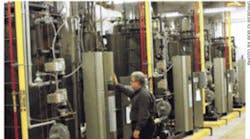One of the largest natural disasters in U.S. history, the Iowa flood of 2008 inundated the city of Cedar Rapids with waters rising to a record 31 ft. Ten square miles was flooded, causing billions of dollars in damage to homes, businesses, and public facilities.
"We had been purchasing our steam from the local utility, which was flooded out and then not rebuilt by its owner," Bob Olberding, director of facilities for Mercy Medical Center, said. "Our temporary solution was to rent boilers on trucks, but we knew we had to come up with a long-term answer to our steam-generation needs." Olberding began researching different brands and models of steam boilers.
"Not having had boilers before, we didn't have opinions about one type of boiler or another," Olberding said. "We read about the efficiency of Miura boilers and how they use a different design from the other brands. We gathered as much information as we could and then followed up with site visits, including one to a community hospital in Milwaukee that had good things to say about Miura. We really liked what we saw, so we made the decision to go with them."
Mercy Medical Center chose to install six EX-300 gas/oil high-pressure steam boilers for its heating, sterilization, and humidification needs. Natural gas is the boilers' primary fuel, with oil providing backup, as required for medical facilities.
The boilers and peripheral equipment were purchased from American Mechanical Services of Milwaukee and installed by Modern Piping of Cedar Rapids.
Green Design
Miura boilers were developed in Japan, where energy costs are higher and pollution-control standards stricter than in the United States. Miura responded by devising a unique "once-through" fin-tube design that requires less fuel and saves—on average—20 percent in energy costs over other boiler designs (based on today’s fuel costs). At a 20-percent fuel savings, Miura boilers can save about $200,000 a year in fuel for a typical 600-bhp steam system (based on a natural-gas price of 9 cents per therm).
Miura boilers emit lower levels of nitrogen oxide (NOx), a major contributor to air pollution, and carbon dioxide, the most prevalent greenhouse gas, than conventional boilers. Miura boilers do that by reducing flame temperature, which, in turn, reduces the amount of excited nitrogen atoms available to bond with oxygen to form NOx. As a result, NOx emissions are reduced to about a quarter of those of traditional firetube boilers and comply with even the most stringent air-quality regulations. The NOx rating of Miura EX Series boilers can be as low as 30 ppm, depending on the model of the boiler.
Olberding said Miura's technology is essential to complying with emissions standards mandated by Iowa's Department of Natural Resources.
"In addition to their low-NOx emissions, our six Miura EX-300 boilers also have exhaust-gas recirculation to reduce emissions even further, so it's a plus for us when surveys are done," Olberding noted. "I believe the emissions produced by Miura boilers are about as low as you can get."
Miura's BOILERMATE eco-friendly, silicate-based water-treatment system further optimizes boiler performance by preventing corrosion and the buildup of scale on internal parts.
Installation Advantages
With their once-through fin-tube design, Miura boilers use less water than traditional firetube boilers. This enables Miura boilers to go from a cold start to full steam in 5 min or less. This "on-demand" steam capability makes the boilers particularly well-suited for multiple-installation plants, in which boilers can be turned on or off as needed, as opposed to left idling on standby, which leads to wasted energy and increased emissions.
"Our Miura boilers kick on and off depending on load and hours of use; it's all computerized," Olberding said, referring to Miura's MI Controller system. The MI Controller turns Mercy Medical Center’s six Miura EX-300 steam boilers on or off in varying numbers to match prevailing load patterns. This achieves the highest possible in-service efficiency, which is a measure of overall boiler performance (regardless of load profile), taking into account all factors of boiler operation, including combustion efficiency, thermal efficiency, and fuel-to-steam efficiency.
"In the summer, we'll just let some of them sit there until we need them for winter," Olberding said. "It has worked out very well."
Computer control of Mercy Medical Center's six EX-300 boilers also involves Miura's BL Micro Controller Boiler Control System, which keeps track of multiple individual monitoring points. This advanced diagnostic system can identify any potential challenge to smooth operation and recommend a solution in plain, descriptive English on an easy-to-read display. An online maintenance system with a "sliding-window" feature records events 4 sec before they occur for quick identification and correction.
Reduced Footprint
Another design advantage is the Miura boilers' comparatively smaller size, Olberding said.
"The Miura boilers take up less space than typical firetube boilers do," Olberding said. "We didn't need as much space as other boiler designs would have required, which is good because we’re right up against our property line. Thanks to the Miura boilers, we have a very nice facility that's not cramped."
Olberding concluded: "Miura is a relatively new style of boiler. It's very efficient and provides low-NOx performance. From what we have seen thus far, we have been very pleased with them, and we believe we have made the right decision."
For Design Solutions author guidelines, call Scott Arnold, executive editor, at 216-931-9980, or write to him at [email protected].










